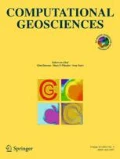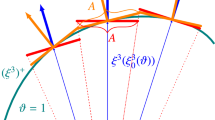Abstract
We perform a convergence analysis of the fixed stress split iterative scheme for the Biot system modeling coupled flow and deformation in anisotropic poroelastic media with tensor Biot parameter. The fixed stress split iterative scheme solves the flow subproblem with all components of the stress tensor frozen using a multipoint flux mixed finite element method, followed by the poromechanics subproblem using a conforming Galerkin method in every coupling iteration at each time step. The coupling iterations are repeated until convergence and Backward Euler is employed for time marching. The convergence analysis is based on studying the equations satisfied by the difference of iterates to show that the fixed stress split iterative scheme for anisotropic poroelasticity with Biot tensor is contractive. We also demonstrate that the scheme is numerically convergent using the classical Mandel’s problem solution for transverse isotropy.
Similar content being viewed by others
References
Abousleiman, Y., Cheng, A.H.D., Cui, L., Detournay, E., Roegiers, J.C.: Mandel’s problem revisited. Géotechnique 46(2), 187–195 (1996)
Almani, T., Kumar, K., Dogru, A., Singh, G., Wheeler, M.F.: Convergence analysis of multirate fixed-stress split iterative schemes for coupling flow with geomechanics. Comput. Methods Appl. Mech. Eng. 311, 180–207 (2016)
Aoki, T., Tan, C.P., Bamford, W.E.: Effects of deformation and strength anisotropy on borehole failures in saturated shales. Int. J. Rock Mech. Min. Sci. Geomech. Abstracts 30(7), 1031–1034 (1993)
Armero, F., Simo, J.C.: A new unconditionally stable fractional step method for non-linear coupled thermomechanical problems. Int. J. Numer. Methods Eng. 35(4), 737–766 (1992)
Biot, M.A.: General theory of three dimensional consolidation. J. Appl. Phys. 12, 155–164 (1941)
Biot, M.A.: Theory of elasticity and consolidation for a porous anisotropic solid. J. Appl. Phys. 26(2), 182–185 (1955)
Biot, M.A.: Mechanics of deformation and acoustic propagation in porous media. J. Appl. Phys. 33(4), 1482–1498 (1962)
Biot, M.A., Willis, D.G.: The elastic coefficients of the theory of consolidation. J. Appl. Mech. 24, 594–601 (1957)
Boresi, A.P., Chong, K.P., Lee, J.D.: Elasticity in Engineering Mechanics, 3rd edn. Wiley (2010)
Brezzi, F., Douglas, J., Durán, R., Fortin, M.: Mixed finite elements for second order elliptic problems in three variables. Numer. Math. 51(2), 237–250 (1987)
Carroll, M.M.: An effective stress law for anisotropic elastic deformation. J. Geophys. Res. 84, B13 (1979)
Carroll, M.M., Katsube, N.: The role of terzaghi effective stress in linearly elastic deformation. J. Energy Resour. Technol. 105(4), 509–511 (1983)
Castelletto, N., White, J.A., Tchelepi, H.A.: Accuracy and convergence properties of the fixed-stress iterative solution of two-way coupled poromechanics. Int. J. Numer. Anal. Methods Geomech. 39(14), 1593–1618 (2015)
Cheng, A.H.D.: Material coefficients of anisotropic poroelasticity. Int. J. Rock Mech. Min. Sci. 34, 199–205 (1997)
Cui, L., Cheng, A.H.D., Kaliakin, V.N., Abousleiman, Y., Roegiers, J.C.: Finite element analyses of anisotropic poroelasticity: A generalized mandel’s problem and an inclined borehole problem. Int. J. Numer. Anal. Methods Geomech. 20(6), 381–401 (1996)
Felippa, C.A., Park, K.C., Farhat, C.: Partitioned analysis of coupled mechanical systems. Comput. Methods Appl. Mech. Eng. 190(24), 3247–3270 (2001)
Geertsma, J.: The effect of fluid pressure decline on volumetric changes of porous rocks. SPE 210, 331–340 (1957)
Gurtin, M.E., Fried, E., Anand, L: The Mechanics and Thermodynamics of Continua, 1st edn. Cambridge University Press (2010)
Ingram, R., Wheeler, M.F., Yotov, I.: A multipoint flux mixed finite element method on hexahedra. SIAM J. Numer. Anal. 48(4), 1281–1312 (2010)
Katsube, N.: The constitutive theory for fluid-filled porous materials. J. Appl. Mech. 52(1), 185–189 (1985)
Kim, J., Tchelepi, H.A., Juanes, R.: Stability, accuracy and efficiency of sequential methods for coupled flow and geomechanics. SPE J. 16(2), 249–262 (2011)
Mikelić, A., Wheeler, M.F.: Convergence of iterative coupling for coupled flow and geomechanics. Comput. Geosci. 17(3), 455–461 (2013)
Mikelić, A., Wang, B., Wheeler, M.F.: Numerical convergence study of iterative coupling for coupled flow and geomechanics. Comput. Geosci. 18(3), 325–341 (2014)
Nur, A., Byerlee, J.D.: An exact effective stress law for elastic deformation of rock with fluids. J. Geophys. Res. 76(26), 6414–6419 (1971)
Phillips, P.J., Wheeler, M.F.: A coupling of mixed and continuous galerkin finite element methods for poroelasticity ii: the discrete-in-time case. Comput. Geosci. 11(2), 145–158 (2007)
Schrefler, B.A., Simoni, L., Turska, E.: Standard staggered and staggered newton schemes in thermo-hydro-mechanical problems. Comput. Methods Appl. Mech. Eng. 144(1-2), 93–109 (1997)
Skempton, A.W.: The pore-pressure coefficients a and b. Géotechnique 4(4), 143–147 (1954)
Skempton, A.W., Peek, R.B.: Significance of terzaghi’s concept of effective stress (terzaghi’s discovery of effective stress). In: Bjerrum, L., Casagrande, A., Skempton, A.W. (eds.) From Theory to Practice in Soil Mechanics, p. 1960. Wiley, New York (1960)
Steele, J.M.: The Cauchy-Schwarz Master Class: An Introduction to the Art of Mathematical Inequalities. Maa Problem Books Series, Cambridge University Press (2004)
Thompson, M., Willis, J.R.: A reformation of the equations of anisotropic poroelasticity. J. Appl. Mech. 58(3), 612–616 (1991)
Ting, T.C.T.: Anisotropic Elasticity: Theory and Applications. The Oxford Engineering Science Series, Oxford University Press (1996)
Turska, E., Schrefler, B.A.: On convergence conditions of partitioned solution procedures for consolidation problems. Comput. Methods Appl. Mech. Eng. 106(1–2), 51–63 (1993)
Author information
Authors and Affiliations
Corresponding author
Appendices
Appendix A: finite element mapping
Let ri, i = 1,.., 8 be the vertices of E. Now, consider a reference cube \(\hat {E}\) with vertices \(\hat {\mathbf {r}}_{1}=[0\,\,0\,\,0]^{T}\), \(\hat {\mathbf {r}}_{2}=[1\,\,0\,\,0]^{T}\), \(\hat {\mathbf {r}}_{3}=[1\,\,1\,\,0]^{T}\), \(\hat {\mathbf {r}}_{4}=[0\,\,1\,\,0]^{T}\), \(\hat {\mathbf {r}}_{5}=[0\,\,0\,\,1]^{T}\), \(\hat {\mathbf {r}}_{6}=[1\,\,0\,\,1]^{T}\), \(\hat {\mathbf {r}}_{7}=[1\,\,1\,\,1]^{T}\) and \(\hat {\mathbf {r}}_{8}=[0\,\,1\,\,1]^{T}\) as shown in Fig. 3. Let \(\hat {\mathbf {x}}=(\hat {x},\hat {y},\hat {z})\in \hat {E}\) and x = (x,y,z) ∈ E. The function \(F_{E}(\hat {\mathbf {x}}):\hat {E}\rightarrow E\) is
Denote Jacobian matrix by DFE and let JE = det(DFE). Defining rij ≡ri −rj, we have
Denote inverse mapping by \(F_{E}^{-1}\), its Jacobian matrix by \(DF_{E}^{-1}\) and let \(J_{F_{E}^{-1}}=det(DF_{E}^{-1})\) such that
Let ϕ(x) be any function defined on E and \(\hat {\phi }(\hat {\mathbf {x}})\) be its corresponding definition on \(\hat {E}\). Then we have
Appendix B: enhanced BDDF1 spaces
For the sake of clarity, we provide a brief description of the mixed finite element spaces used in the flow model. Let \(\mathbf {V}^{*}_{h}\times W_{h}\) be the lowest order BDDF1 MFE spaces on hexahedra (see Brezzi et al. [10]). On the reference unit cube, these spaces are defined as
with the following properties
The multipoint flux approximation procedure requires on each face one velocity degree of freedom to be associated with each vertex. Since the BDDF1 space \(\mathbf {V}^{*}_{h}\) has only three degrees of freedom per face, it is augmented with six more degrees of freedom (one extra degree of freedom per face). Since the constant divergence, the linear independence of the shape functions and the continuity of the normal component across the element faces are to be preserved, six curl terms are added [19]. Let Vh × Wh be the enhanced BDDF1 spaces on hexahedra. On the reference unit cube, these spaces are
with the following properties
where \(\mathbb {Q}_{1}\) is the space of bilinear functions. Since \(dim\,\mathbb {Q}_{1}(\hat {e})= 4\), the dimension of \(\hat {\mathbf {V}}(\hat {E})\) is 24 as shown in Fig. 4.
Appendix C: discrete variational statements for the flow subproblem in terms of coupling iteration differences
Before arriving at the discrete variational statement of the flow model, we impose the fixed stress constraint on the strong form of the mass conservation (1). In lieu of Eq. 13, we write (1) as
Using backward Euler in time, the discrete in time form of Eq. 40 for the mth coupling iteration in the (n + 1)th time step is written as
where Δt is the time step and the source term as well as the terms evaluated at the previous time level n do not depend on the coupling iteration count as they are known quantities. The fixed stress constraint implies that σm,n+ 1 gets replaced by σm− 1,n+ 1 i.e. the computation of pm,n+ 1 and zm,n+ 1 is based on the value of stress updated after the poromechanics solve from the previous coupling iteration m − 1 at the current time level n + 1. The modified equation is written as
As a result, the discrete weak form of Eq. 1 is given by
Replacing m by m + 1 and subtracting the two equations, we get
The weak form of the Darcy law (2) for the mth coupling iteration in the (n + 1)th time step is given by
where V(Ω) is given by
and H(div,Ω) is given by
We use the divergence theorem to evaluate the first term on RHS of Eq. 41 as follows
where we invoke v ⋅n = 0 on \({{\Gamma }_{N}^{f}}\). In lieu of Eqs. 41 and 42, we get
Replacing m by m + 1 and subtracting the two equations, we get
Appendix D: discrete variational statement for the poromechanics subproblem in terms of coupling iteration differences
The weak form of the linear momentum balance (6) is given by
where U(Ω) is given by
where Hm(Ω) is defined, in general, for any integer m ≥ 0 as
where the derivatives are taken in the sense of distributions and given by
We know from tensor calculus that
Further, using the divergence theorem and the symmetry of σ, we arrive at
We decompose ∇q into a symmetric part \((\nabla \mathbf {q})_{s}\equiv \frac {1}{2}\big (\nabla \mathbf {q}+(\nabla \mathbf {q})^{T}\big )\equiv \boldsymbol {\epsilon }(\mathbf {q})\) and skew-symmetric part (∇q)ss and note that the contraction between a symmetric and skew-symmetric tensor is zero to obtain

From Eqs. 43, 44, 45 and 46, we get
which, after invoking the traction boundary condition, results in the discrete weak form for the mth coupling iteration as
Replacing m by m + 1 and subtracting the two equations, we get
Appendix E: contracted notation
The generalized Hooke’s law (11) written in indicial notation
is rewritten in contracted notation as
where the transformation is accomplished by replacing the subscripts ij (or kl) by β (or γ) using the following rules
In other words, the stress and strain tensors are represented as
Appendix F: material symmetry
A material is said to possess a symmetry with respect to an orthogonal transformation χ if the elasticity tensor \(\mathbb {M}\) is invariant under the orthogonal transformation χ as follows (see Ting [31])
where \(\mathbb {M}^{\prime }\) is the transformed elasticity tensor and K is given by
where χ given by
is a reflection with respect to a plane whose normal is n. The plane is also referred to as the plane of material symmetry.
1.1 F.1 Transverse isotropy
The symmetry planes can be one of the following three possibilities
-
1.
x = 0 plane and any plane that contains the x-axis
-
2.
y = 0 plane and any plane that contains the y-axis
-
3.
z = 0 plane and any plane that contains the z-axis
For the Mandel’s problem (see Fig. 2), the material symmetry planes are the second possibility (y = 0 plane and any plane that contains the y-axis). In lieu of that, the elasticity tensor \(\mathbb {M}\) reduces to
with five independent components \(\mathbb {M}_{11}\), \(\mathbb {M}_{12}\), \(\mathbb {M}_{13}\), \(\mathbb {M}_{22}\) and \(\mathbb {M}_{44}\).
Rights and permissions
About this article
Cite this article
Dana, S., Wheeler, M.F. Convergence analysis of fixed stress split iterative scheme for anisotropic poroelasticity with tensor Biot parameter. Comput Geosci 22, 1219–1230 (2018). https://doi.org/10.1007/s10596-018-9748-2
Received:
Accepted:
Published:
Issue Date:
DOI: https://doi.org/10.1007/s10596-018-9748-2






